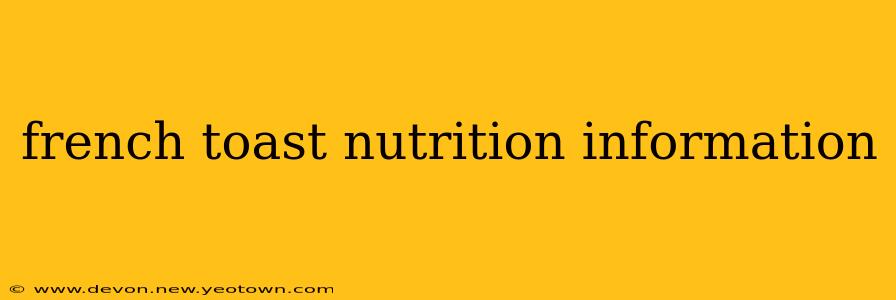French toast. Just the name conjures up images of warm, comforting breakfasts, perhaps a weekend brunch with family, or a cozy morning treat. But what about the nutritional side of this beloved dish? Let's delve into the delicious details and explore the nutritional information behind this classic breakfast favorite. This isn't just about calories; we'll uncover the macronutrient breakdown, potential health benefits, and ways to make your French toast a little healthier.
What are the calories in French Toast?
The calorie count in a slice of French toast varies significantly depending on several factors. The type of bread used (challah, brioche, sourdough all have different calorie densities), the amount of egg and milk in the custard, the amount of butter or oil used for cooking, and even the added toppings all contribute to the final calorie count. A typical slice of French toast made with white bread, a modest amount of egg and milk, and cooked with a small pat of butter might clock in around 200-250 calories. However, adding syrup, whipped cream, or fruit can easily push that number over 300 or even 400 calories.
How much protein, carbs, and fat are in French Toast?
The macronutrient breakdown mirrors the variability in calorie count. Generally, French toast is higher in carbohydrates due to the bread base. The protein content comes primarily from the eggs in the custard, while the fat content varies depending on the type of bread, the amount of butter or oil used, and added toppings. A typical serving might contain roughly:
- Carbohydrates: 25-35 grams
- Protein: 5-10 grams
- Fat: 8-15 grams
These are just estimates, and the actual values will depend heavily on the specific ingredients and preparation method.
Is French Toast healthy?
This is a complex question. In moderation, French toast can be part of a balanced diet. It does provide some protein and carbohydrates for energy, but it's also relatively high in calories and often contains added sugars from syrup or other toppings. The type of bread used plays a crucial role; whole-wheat or multigrain bread offers more fiber and nutrients than white bread.
Focusing on healthier cooking methods—using a non-stick pan and minimizing added butter or oil—can also help reduce the overall fat content. Consider adding fruit for extra vitamins and antioxidants instead of relying on sugary syrups.
What are the benefits of eating French Toast?
While not a nutritional powerhouse, French toast does offer some potential benefits when consumed in moderation:
- Energy boost: The carbohydrates provide a source of energy, particularly useful for a breakfast meal.
- Protein source: The eggs contribute to the protein content, important for building and repairing tissues.
- Comfort food: The warm, comforting nature of French toast can be psychologically beneficial.
How can I make healthier French Toast?
The beauty of French toast lies in its versatility. Here are some tips for making a healthier version:
- Use whole-wheat or multigrain bread: This increases the fiber content and adds more nutrients.
- Reduce the amount of butter or oil: Use a non-stick pan and a light spray of cooking oil.
- Add fruit for sweetness: Berries, bananas, or sliced apples provide natural sweetness and additional vitamins.
- Use less syrup: Opt for a small amount of maple syrup or try a sugar-free alternative.
- Consider egg substitutes: For those seeking lower cholesterol, egg substitutes can be used.
By making mindful choices regarding ingredients and preparation, you can enjoy this breakfast classic while still maintaining a balanced and healthy diet. Remember, moderation and conscious ingredient selection are key to enjoying your favorite foods without compromising your health goals.

